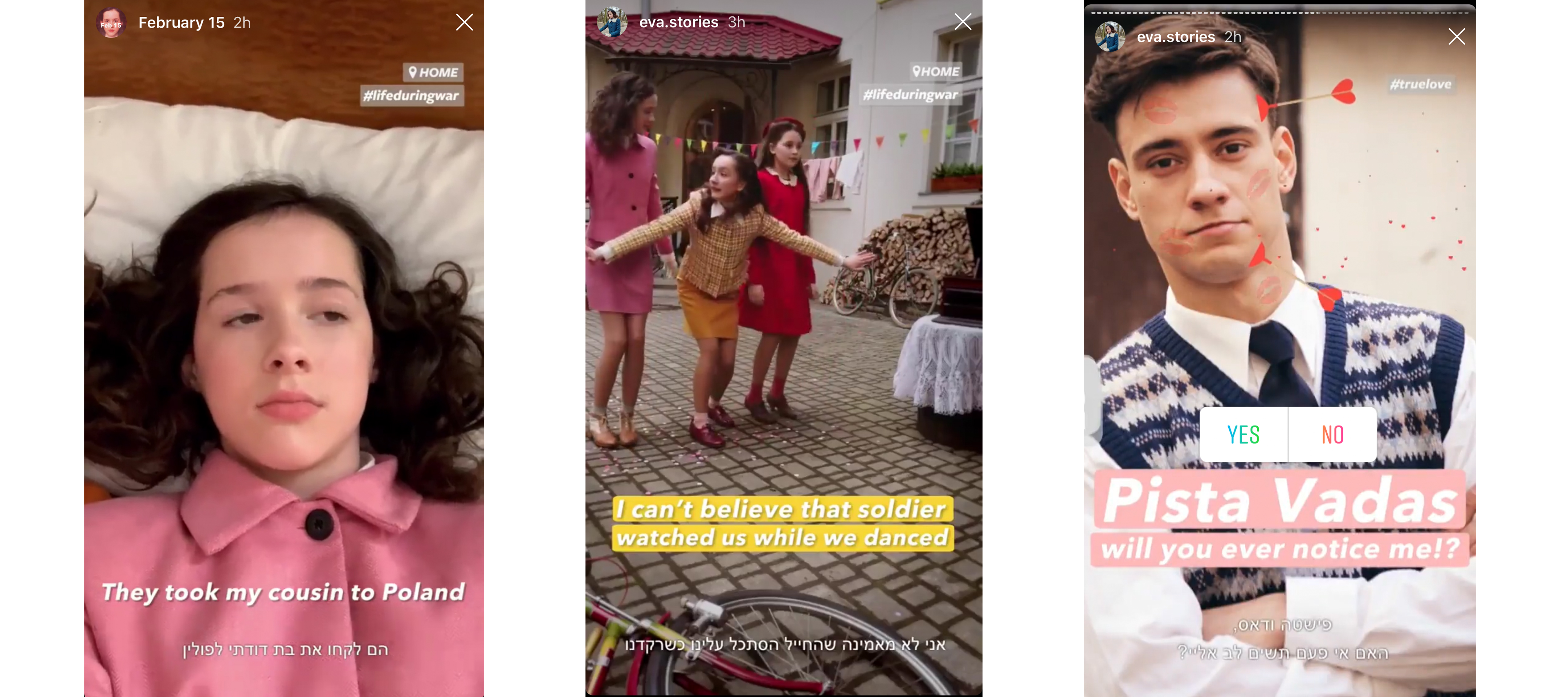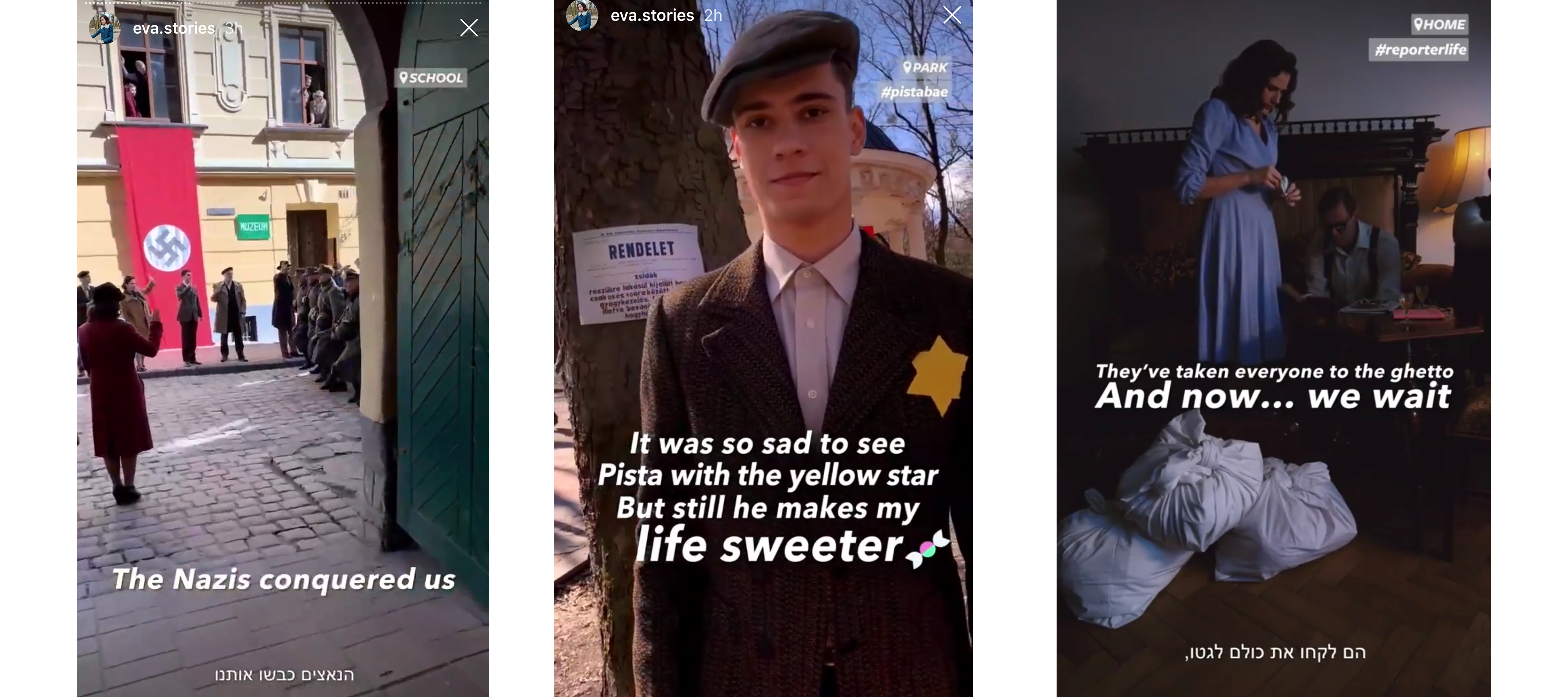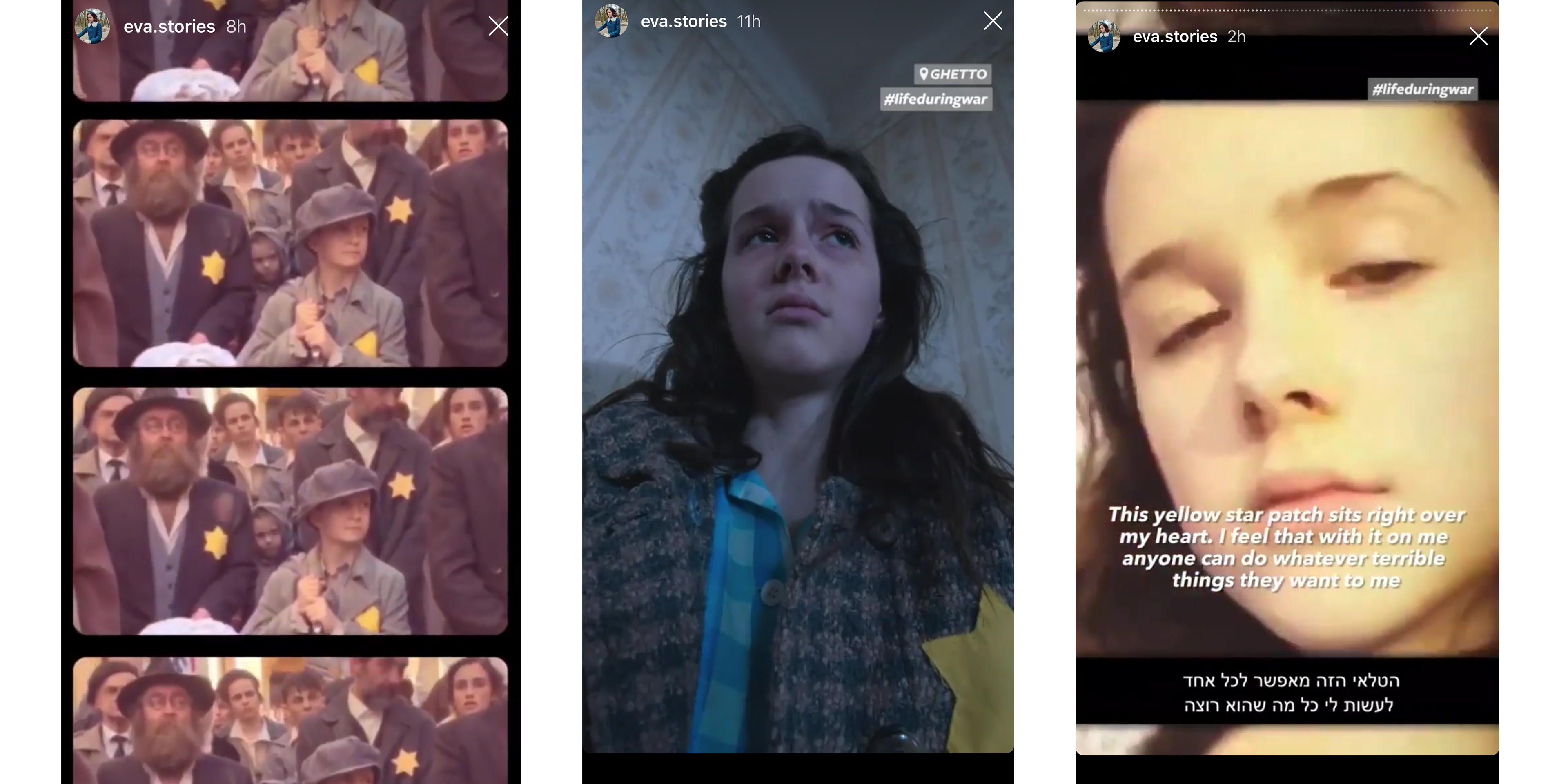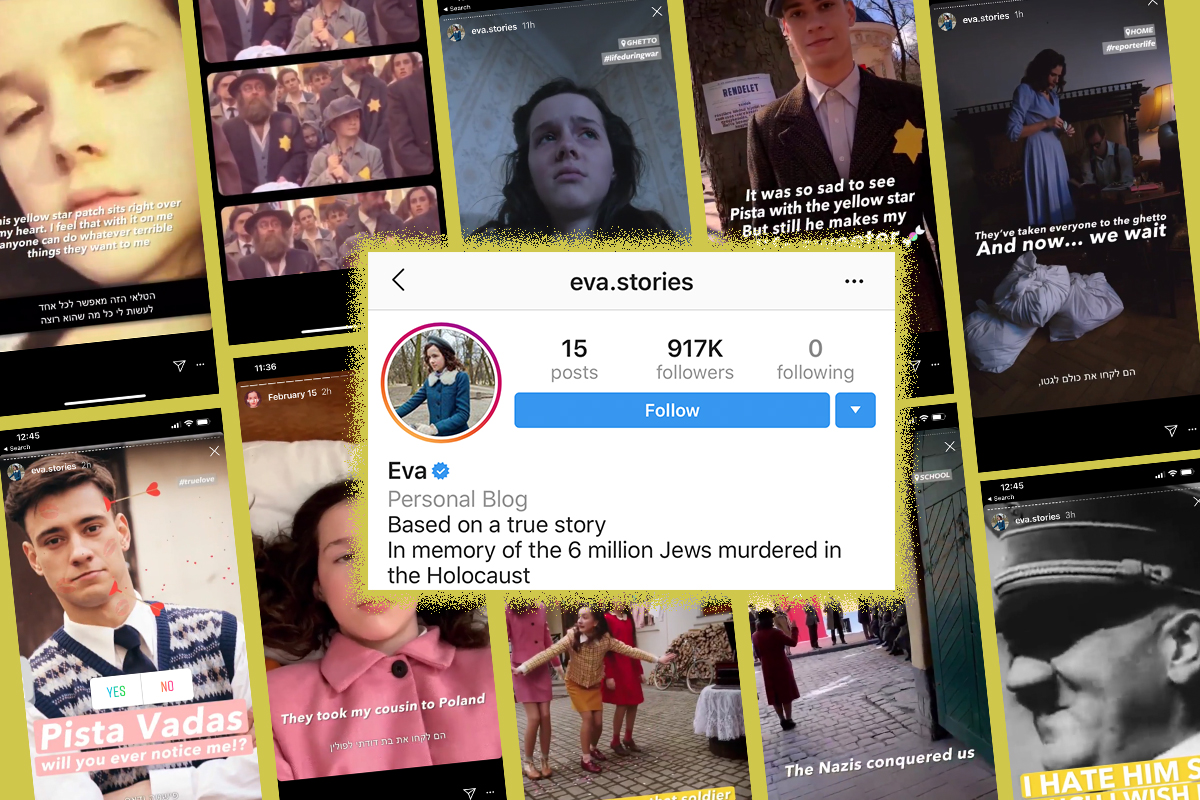Have you heard of an Instagram account called Eva Stories? The premise is relatively straightforward: What if a Jewish girl living during the Holocaust had Instagram? Everyone from Israeli actress Gal Gadot to Israeli Prime Minister Benjamin Netanyahu has promoted the account, and it’s gotten write-ups in publications as mainstream as The New York Times. My office Slack channel has been talking about it for days. But what we can’t figure out is: Is it good?
Eva Stories (@eva.stories) is an Instagram account sharing produced stories based off the life of a real girl named Eva Heyman, who kept a diary as a young Jewish girl in Hungary. Eva, at age 13, was murdered at Auschwitz in October 1944. The project aims to tell Eva’s story in a unique way to connect with teens. It’s funded and produced by Israeli entrepreneur Mati Kochavi, who spearheaded the multi-million dollar production (yes, really). The project was filmed in Lviv, Ukraine “with the assistance of some 400 actors, extras, and production assistants.” All the stories were posted over the span of 24 hours on Yom Hashoah, Holocaust Memorial Day.
Eva Stories is mostly intended for teens — the “social media generation” — with the mission of making Holocaust studies more accessible. Kochavi explained it thusly: “If we want to bring the memory of the Holocaust to the young generation, we have to bring it to where they are.”
And they are on Instagram, that’s for sure. But while I think the intent is great — we need more Holocaust education, not less — there’s something about Eva Stories that I find deeply unsettling. Where the project loses me is in its execution.
For one, it doesn’t speak to how a teen would use Instagram today. It’s how an adult thinks a teen uses Instagram.
Uploading the stories over a 24-hour period, instead of in real-time as it would have actually happened for Eva, means the stories won’t pop up on followers’ feeds after the 24 hours are over. Think of how much more effective this could have been if the stories were updated every day, reminding @eva.stories’s followers about the slow-burn and terrifying nature of the Holocaust? How one day everything was normal, and the next, Jews were being deported?
But then there’s the content itself.

For a project like this to be impactful, the updates need to be believable. Let’s look at the above screenshot, starting with the right: What teen (or adult for that matter) would ever post a picture of her crush with the poll “Will you ever notice me?” on social media? Not a single person! I’m embarrassed for adults who think this is how teens use Instagram!
“They took my cousin to Poland,” is the text on a selfie of Eva, with the hashtag #lifeduringwar, on the left. Do the creatives behind Eva Stories think turning the murder of Jews at concentration camps into “#lifeduringwar” makes sense? More #relatable to teens? Easier to digest? Teens are a lot smarter than we give them credit for, and above all, crave authenticity on social media. They’re not turning the Holocaust into pithy hashtags.
The historical moments that make it onto Eva’s story also feel super off to me.

What teen is nonchalantly videoing Nazis and captioning it, “The Nazis conquered us”? Same with that middle screenshot: a picture of Eva’s boyfriend, Pista, wearing his yellow Star of David, with the hashtag #pistabae in the corner. Again: what teen!?
To be fair, not everyone agrees with me.
“The stories feel intimate in the way the best Instagram accounts do. As a viewer you experience them intimately by holding the phone in your hand, putting headphones in your ears. It makes the story of one girl’s experience in the Holocaust feel personal. It is emotionally powerful and individualizes the scale of the Holocaust in the same way that testimonies do,” Dr. Rachel Deblinger, a Holocaust historian and Co-Director of the Digital Jewish Studies Initiative at UC Santa Cruz, explained to me.
Others who watched it shared that same reaction. “It actually was extremely impactful in its use of the media and the production quality is astounding. I was in tears,” Alma Ambassador Jenna Teplitzky told me.

“I think it’s a sign of a shift in Holocaust memory,” Dr. Shayna Weiss, Associate Director of the Schusterman Center for Israel Studies at Brandeis University, explained to me. “Commemoration and memory is always changing, and we can’t rely on direct survivor testimony.” I agree: New ways of commemorating those who were murdered is important, another nod to why Holocaust fiction remains so popular in 2019.
Dr. Deblinger echoed this when I spoke with her: “The placement of the stories between Instagram ads and celebrity photos makes the project more impactful. They’re like digital stolpersteins in your feed: You are forced to stop and contemplate the Holocaust while going about the everyday business of scrolling.”
Stolpersteins, literally “stumbling stone” in German, are placed in the pavement in many European countries as a way of commemorating victims of the Holocaust. The project has placed over 60,000 stones, commemorating the last residences of victims. As Jewniverse explains, “Through this unassuming but powerful memorial to the victims of the Nazis, they remind us: These people lived here, in this house, on this street, and could have been our neighbors.”

I love the idea of Eva Stories as “digital stolpersteins,” and I do not want to discount that this could be monumental for teens in viewing the Holocaust through someone else’s eyes. When I chatted with an Alma Ambassador, Hannah, she agreed: “I feel like it could be really important for people to see these events from the perspective of someone with whom they have similar characteristics.” Yet, she added, “I personally have very little interest in watching what is essentially the story of my family play out on social media.” Which brings up a great point: does anyone?
There are plenty of other powerful ways to use social media to tell Holocaust stories. Take the Twitter account “St. Louis Manifest,” which tweets out the names of Jewish refugees turned away from America during the war.
My name is Fanny Mayer. The US turned me away at the border in 1939. I was murdered in Auschwitz #NeverAgain #RefugeesWelcome
— St. Louis Manifest (@Stl_Manifest) January 28, 2019
My name is Willi Dublon. The US turned me away at the border in 1939. I was murdered in Auschwitz #NeverAgain #RefugeesWelcome pic.twitter.com/GTQ3hWZH2Z
— St. Louis Manifest (@Stl_Manifest) January 28, 2019
My name is Abraham Wolf. The US turned me away at the border in 1939. I was murdered in Theresienstadt #NeverAgain #RefugeesWelcome
— St. Louis Manifest (@Stl_Manifest) January 28, 2019
It’s effective in its simplicity, reminding Twitter users throughout their day of the Jews who were turned away from America in 1939 and then murdered in the Holocaust. And it’s not alone.
“I think we will see more and more use of this kind of contemporary media engagement with the Holocaust and I’m all for it,” Dr. Deblinger told me. “The use of Instagram in this way is entirely in line with the history of Holocaust memory and commemoration. Jews under Nazism used whatever tools they had to document their treatment under Nazism. After the war, survivors wrote, recorded, and testified about their experience. Why should we not use the platforms and tools of the moment to continue telling these stories?”
Which, yes. Holocaust education should begin to utilize social media as a proper tool. But, we should also turn to examples of children who are currently surviving tragedy and sharing their stories on social media. Dr. Deblinger pointed to Bana Alabed’s Twitter feed as one example. Bana is a 9-year-old Syrian girl who lived through the siege of Aleppo, and shared updates with the help of her mom. (Her family has since left Syria.)
Or Malala Yousafzai, 21, who was shot by a Taliban gunman in the head when she was 15. She had been blogging for BBC Urdu, anonymously, as she lived through battles in her native Pakistan. Her identity was revealed after about a year, and she began appearing on television, which made her a target. After surviving the assassination attempt, she has become a worldwide advocate for girls’ education through the Malala Fund.
“There are so many kids documenting living through war-torn countries, mass murder, tragedies right now. There are stories already being told in this way. Our history and loss doesn’t need to be re-framed in this way,” Stella Boonshoft told me, referring back to @eva.stories.
“Social media can provide everyone with the tools to document and share their own experience and draw the world’s attention to perspectives that have been historically silenced. But, we have seen the consequences of broadcasting state sponsored violence on social media and Eva’s Stories fail to engage with the dangers of social media,” Dr. Deblinger explains. “If we really are supposed to imagine what it would be like if Instagram had been around during the Holocaust, where are the ramifications of social media? Where is the interactivity? Where is the hateful online bullying that certainly would have been part of a Nazi onslaught of hate? Instagram is a social media platform, not a private video diary. Wouldn’t her data have been tracked by the Nazis? The Nazis or local collaborators could easily have used the account to find her stepfather and further punish her family (not to mention the woman willing to hide Eva).”
While we can applaud any attempt to make the Holocaust more relevant to the younger generations, if it’s not done in an authentic way that will truly speak to teens, then I’m afraid this multi-million dollar initiative might not be worth following.



